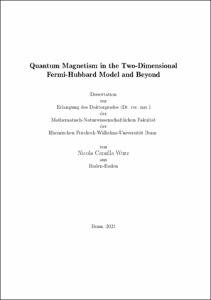Wurz, Nicola Camilla: Quantum Magnetism in the Two-Dimensional Fermi-Hubbard Model and Beyond. - Bonn, 2022. - Dissertation, Rheinische Friedrich-Wilhelms-Universität Bonn.
Online-Ausgabe in bonndoc: https://nbn-resolving.org/urn:nbn:de:hbz:5-65535
Online-Ausgabe in bonndoc: https://nbn-resolving.org/urn:nbn:de:hbz:5-65535
@phdthesis{handle:20.500.11811/9733,
urn: https://nbn-resolving.org/urn:nbn:de:hbz:5-65535,
author = {{Nicola Camilla Wurz}},
title = {Quantum Magnetism in the Two-Dimensional Fermi-Hubbard Model and Beyond},
school = {Rheinische Friedrich-Wilhelms-Universität Bonn},
year = 2022,
month = apr,
note = {Ultracold quantum gases in optical lattices serve as an analogue quantum simulator to investigate the physics of strongly correlated materials. With our quantum gas setup we investigate fermionic potassium atoms in a single layer of an anisotropic three-dimensional optical lattice configuration. The physics of this system is captured by the two-dimensional Fermi-Hubbard model, which includes only two elementary processes, namely tunnelling between neighbouring lattice sites with amplitude t and on-site interactions between opposite spins of strength U. The combination of high-resolution imaging and radio-frequency spectroscopy enables us to observe the in-situ density distribution of a single two-dimensional layer. We can either detect magnetic correlations by employing a spin-resolved imaging scheme or we can study the density sector by resolving the spatial distribution of singly and doubly occupied sites.
We have successfully employed a novel technique to coherently manipulate magnetic correlations. This allowed us to quantify the magnetic order of a two-dimensional layer in quasimomentum space and was furthermore used to perform thermometry at temperatures where charge excitations are mostly frozen out. In contrast to the temperature obtained from the global density profile, our spin thermometer represents a local probe, and combining both techniques enables us to study non-equilibrium properties of our system.
By implementing a superlattice along the vertical lattice direction, we can couple two horizontal layers in a controlled way. This allows us to study the bilayer Fermi-Hubbard model, which adds yet another energy scale, namely the vertical tunnel coupling, t⟂. We have adapted a measurement scheme to access the magnetic correlations between neighbouring layers by inducing coherent singlet-triplet oscillations along the vertical bond and successively merging the double-well like potential into a single well. We have investigated the influence of the tunnel coupling between the two layers over a large parameter range of 0 ≤ t⟂ ≤ 5t and we have observed that the direction along which magnetic correlations predominantly form changes. Our results confirm the expectation of a crossover between the two low-temperature phases, i.e. a two-dimensional antiferromagnet within the layer and a band insulator of singlet pairs along the vertical direction for strong coupling between the layers. In addition, we have measured the compressibility of the bilayer system by applying an in-plane magnetic field gradient and thereby confirmed the strongly insulating nature of the bilayer band insulator.},
url = {https://hdl.handle.net/20.500.11811/9733}
}
urn: https://nbn-resolving.org/urn:nbn:de:hbz:5-65535,
author = {{Nicola Camilla Wurz}},
title = {Quantum Magnetism in the Two-Dimensional Fermi-Hubbard Model and Beyond},
school = {Rheinische Friedrich-Wilhelms-Universität Bonn},
year = 2022,
month = apr,
note = {Ultracold quantum gases in optical lattices serve as an analogue quantum simulator to investigate the physics of strongly correlated materials. With our quantum gas setup we investigate fermionic potassium atoms in a single layer of an anisotropic three-dimensional optical lattice configuration. The physics of this system is captured by the two-dimensional Fermi-Hubbard model, which includes only two elementary processes, namely tunnelling between neighbouring lattice sites with amplitude t and on-site interactions between opposite spins of strength U. The combination of high-resolution imaging and radio-frequency spectroscopy enables us to observe the in-situ density distribution of a single two-dimensional layer. We can either detect magnetic correlations by employing a spin-resolved imaging scheme or we can study the density sector by resolving the spatial distribution of singly and doubly occupied sites.
We have successfully employed a novel technique to coherently manipulate magnetic correlations. This allowed us to quantify the magnetic order of a two-dimensional layer in quasimomentum space and was furthermore used to perform thermometry at temperatures where charge excitations are mostly frozen out. In contrast to the temperature obtained from the global density profile, our spin thermometer represents a local probe, and combining both techniques enables us to study non-equilibrium properties of our system.
By implementing a superlattice along the vertical lattice direction, we can couple two horizontal layers in a controlled way. This allows us to study the bilayer Fermi-Hubbard model, which adds yet another energy scale, namely the vertical tunnel coupling, t⟂. We have adapted a measurement scheme to access the magnetic correlations between neighbouring layers by inducing coherent singlet-triplet oscillations along the vertical bond and successively merging the double-well like potential into a single well. We have investigated the influence of the tunnel coupling between the two layers over a large parameter range of 0 ≤ t⟂ ≤ 5t and we have observed that the direction along which magnetic correlations predominantly form changes. Our results confirm the expectation of a crossover between the two low-temperature phases, i.e. a two-dimensional antiferromagnet within the layer and a band insulator of singlet pairs along the vertical direction for strong coupling between the layers. In addition, we have measured the compressibility of the bilayer system by applying an in-plane magnetic field gradient and thereby confirmed the strongly insulating nature of the bilayer band insulator.},
url = {https://hdl.handle.net/20.500.11811/9733}
}






